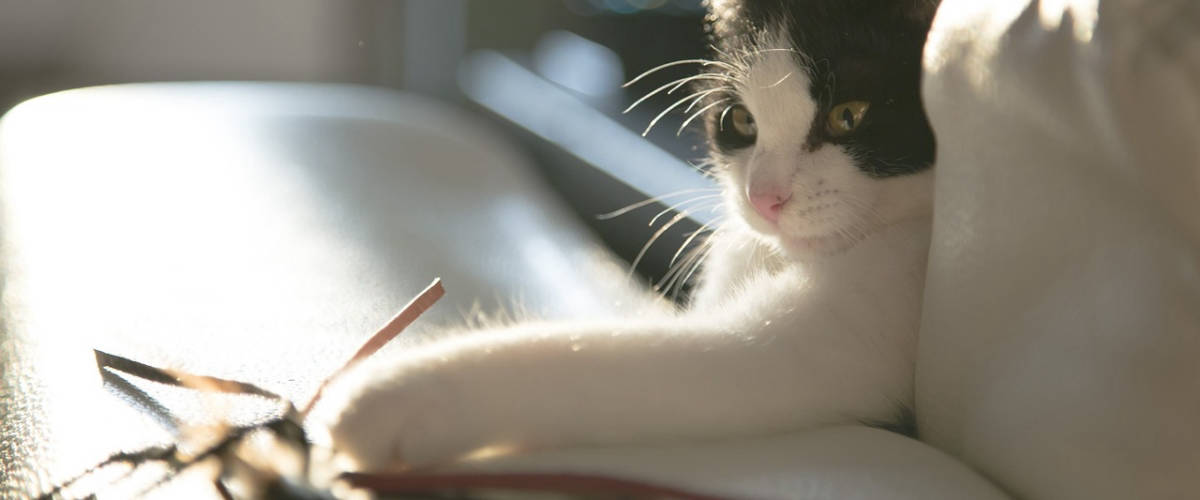Cats seem to be the perfect apartment pet: small, quiet, independent. But if you aren’t careful to keep your cat happy and entertained, you can kiss your wooden door frames and pee-free couch cushions goodbye. And just because they’re low-maintenance, that doesn’t mean they’re no-maintenance.
Aside from the hours of petting and playing, you should expect your cat to cost you at least $300 a year in food, toys, vet bills, and other various expenses, according to PetEducation.com.
Do cats really need toys?
Yes — and many of them. Cats can easily become restless and start clawing anything they can get their paws on. Here’s how to keep them entertained and keep their feline instincts in check.
Finding a Pet-Friendly Rental
But before we optimize your apartment for your cat’s best life, you should make sure that your apartment allows cats to begin with. Because of the potential damage cats can cause — between claws, teeth, fur, and “fluids” — many property managers would prefer you keep your kitties elsewhere. If you’re in the middle of your lease, there’s not much you can do, and we don’t recommend trying to hide any roommate, no matter how small.
If a feline is in your future, there are many ways to go about finding a cat-friendly apartment. On Rentable, you can add your cat filter alongside your other hopes and dreams (in-unit laundry or balcony, perhaps), and find dozens of places that fit the bill.
Or, you can head to our pet-friendly apartments page, which has resources — like an adorable pet resume — to get you started.
Choosing an Apartment Cat
Most cat breeds would be a fine fit for apartment life, but a few stand out as exceptionally good options due to low activity levels and hesitance to use claws.
- American shorthair — A classic for a reason, these friendly cats are low-maintenance and get along well with other pets. They were first bred as rat-hunters, so you’ll want to be sure to give them toys to exercise their instincts.
- British shorthair — Much like the American shorthair, these cats get along well with others and are very affectionate and low-maintenance. They’re also quite clumsy and on the larger side (the males reaching up to 17 pounds), so you needn’t worry about midnight acrobatics — at least not successful midnight acrobatics.
- Ragdolls/ragamuffins — Along with their even more docile relative, ragamuffins — yes, that’s a real thing — ragdolls are very affectionate and patient cats that typically play without using their claws. If feline indifference is a turnoff for you, a ragamuffin or ragdoll is a perfect fit. They come when called, follow you from room to room, and greet you at the door.
- Russian blue — Named for their short gray-blue coats, these cats don’t shed excessively. They love playing fetch and getting pats on the head.
- Persian — With short legs and stocky bodies, Persian cats would rather drape themselves over the arm of a couch than jump onto a shelf of your breakables. Their long, thick coats necessitate regular brushing and cleaning, and their voices are naturally quiet so you won’t alarm the neighbors when it’s bath time. If you don’t want that kind of maintenance, the exotic breed is similar but with shorter hair.

Keeping Your Cat Happy in a Small Space
A bored cat is a dangerous cat — scratched furniture and door frames, messes outside of the litterbox, and so on. But all of that can be kept at bay by providing your cat with ample stimulation and cat accessories.
- Add a cat tree, or other elevated point.
Have you struggled to get your cat down from the top of the refrigerator? There’s a reason she’s gargoyling up there. Cats instinctively seek out tall locations where they can feel secure and in charge of their domains while keeping an eye out for potential attacks. Cat trees or a series of securely installed wall shelves can do the trick. - Get a scratching post, or a few.
Incessant scratching isn’t destructive behavior — in fact, it’s necessary to scrape off the outer layer of their claws and helps them to mark their territory and stretch. Discourage scratching in unwelcome spots by spraying citrus cents or wrapping in sticky tape, and encourage them to use scratching posts by spraying on a bit of liquid curiosity: cat nip. - Make time to play.
Even the laziest cats like to bat things around from time to time, so make sure you set aside time to actively engage with your cat for play and affection. Also set up toys that encourage them to play even when you aren’t involved, such as an interactive laser toy, a securely hung string or feather bundle, or a high-tech hide-and-seek toy. - Give them a window seat.
Suction-cup cat baskets can give your pet the vantage point they love while gazing out the window. Place a bird feeder nearby, and they’re guaranteed constant entertainment. - Research plants poisonous to cats.
For your own sanity as well as your cat’s safety, keep your most prized plants in unreachable locations and/or line the pots with sticky tape to discourage cats from tampering. Lilies, tulips, Spanish thyme, oleander, English ivy, azaleas and other plants can be toxic to cats and shouldn’t be kept anywhere near them. - Use calming scents.
Housecats, believe it or not, can get very stressed out and unhappy, which can lead to terror for your apartment and belongings. Lavender and chamomile diffusers can help keep kitty calm and relaxed, as can certain pheromones. If you’re having problems with cats fighting, scratching, or urine marking, consider getting a spray, collar, or diffuser with calming cat pheromones.
You and your cat can be happy in any apartment if you put in the time and effort to keep your pet engaged and exercised.
For more tips, read our complete guide to pet-friendly apartment living.
